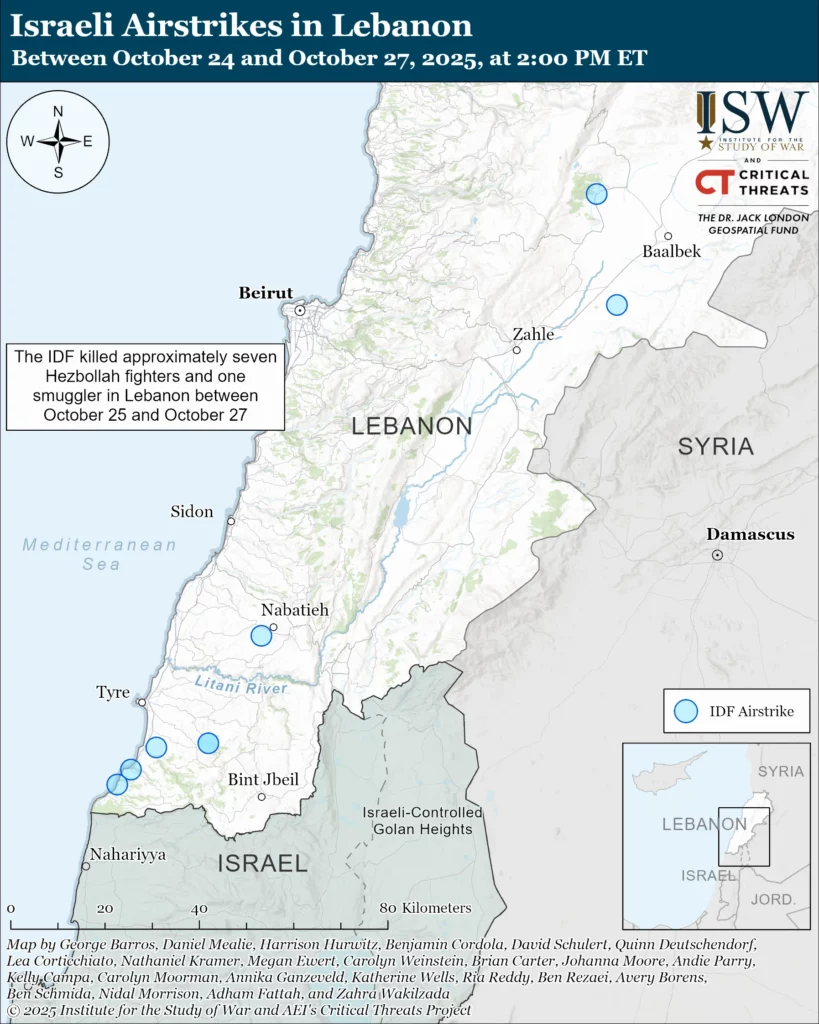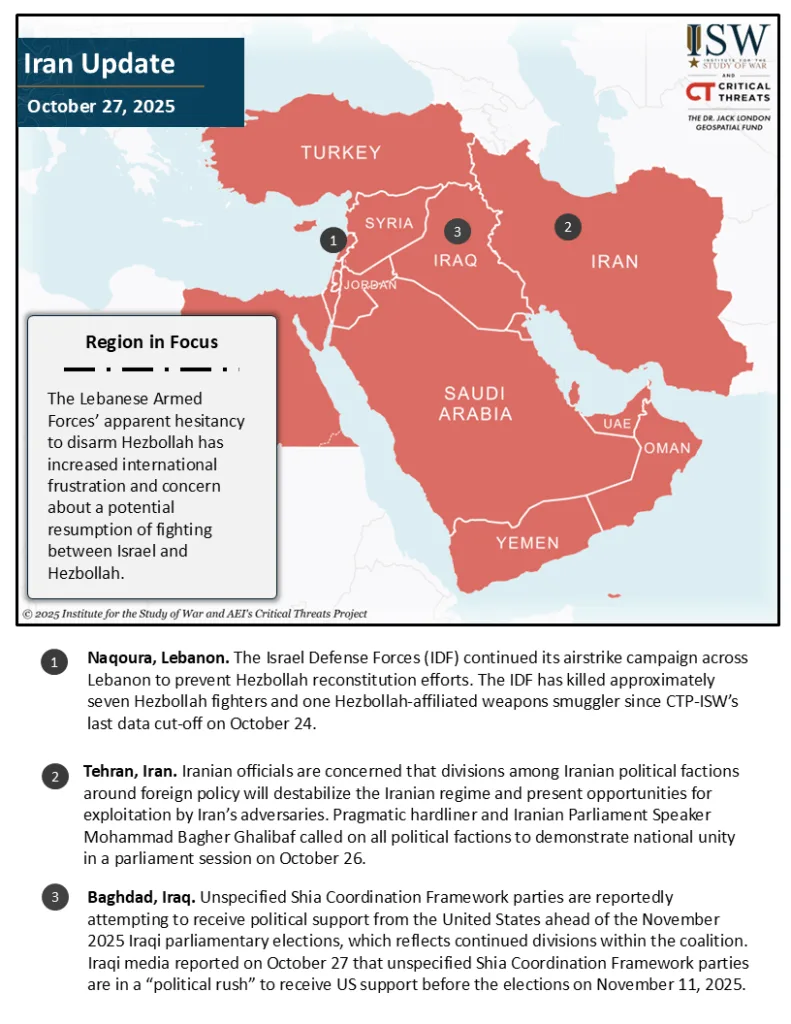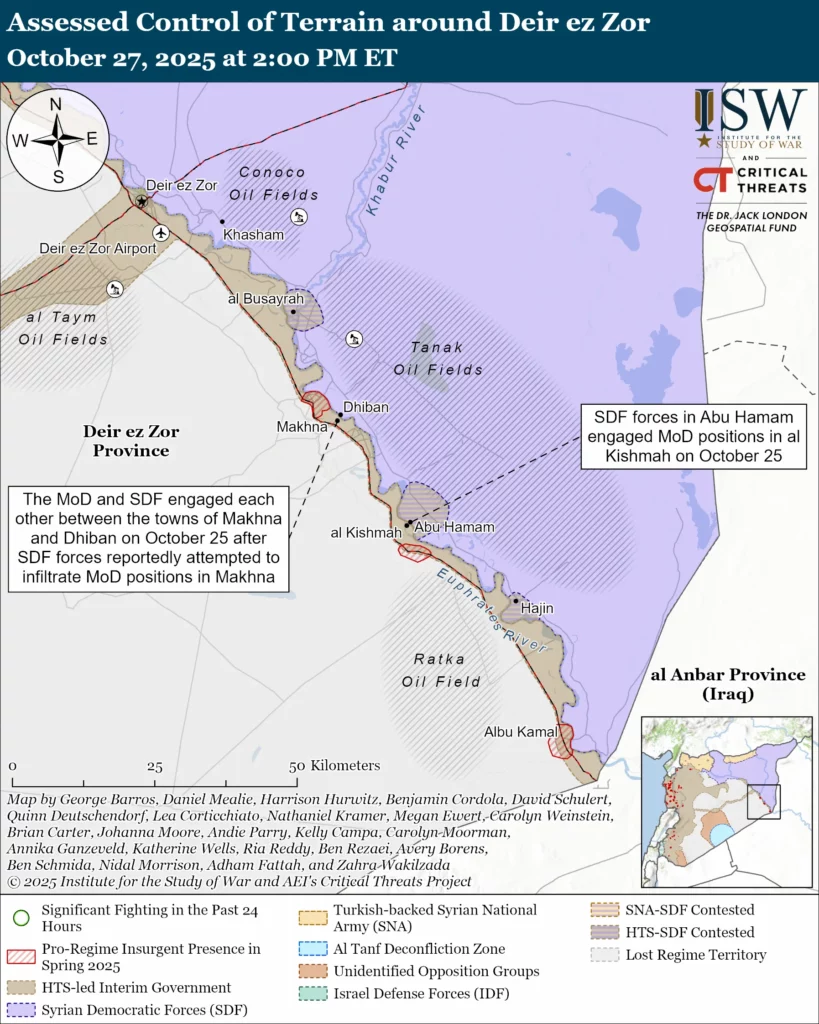The Lebanese Armed Forces (LAF)’s apparent hesitancy to disarm Hezbollah has increased international frustration and concern about a potential resumption of fighting between Israel and Hezbollah. Deputy US Special Envoy Morgan Ortagus arrived in Beirut on October 27 to meet with senior Lebanese officials in hopes of preventing renewed fighting between Israel and Hezbollah.[1] Ortagus is expected to attend a ceasefire supervision committee meeting and meet with Lebanese President Joseph Aoun during her visit.[2] CTP-ISW assessed on October 23 that Hezbollah may have deterred the LAF from disarming the group.[3] The LAF has conducted basic seizures of Hezbollah weapons caches, but CTP-ISW has not observed any instances of Hezbollah fighters turning weapons over to the state. LAF leadership and members of Lebanon’s security forces were divided over their willingness to act against Hezbollah in August 2025, according to unspecified sources speaking to Lebanese and Emirati media.[4] The Lebanese government has claimed that Israeli airstrikes have prevented the LAF from more forcefully or efficiently disarming Hezbollah.[5] Lebanese officials and the LAF have failed to concretely explain how the Israelis limit LAF activity and why the LAF cannot implement its plan to disarm Hezbollah with its existing capabilities. Regional and international partners have expressed frustration with the Lebanese government’s cautious disarmament process.[6] The Israel Defense Forces (IDF) launched a five-day division-level exercise along the Israel-Lebanon border on November 19 amid these international frustrations. The IDF said that the exercise sought to maintain readiness along Israel’s northern border and prepare for unspecified “different scenarios.”[7] US Special Envoy Thomas Barrack warned the Lebanese government on November 20 that there may be a “major confrontation” between Israel and Hezbollah if the Lebanese government does not take steps to disarm Hezbollah.[8]
The IDF has continued its airstrike campaign across Lebanon to prevent Hezbollah reconstitution efforts. The IDF has killed approximately seven Hezbollah fighters and one Hezbollah-affiliated weapons smuggler since CTP-ISW’s last data cutoff on October 24.[9] The IDF reported that it killed two Hezbollah Radwan Force fighters and two Radwan commanders who supported Hezbollah reconstitution efforts in southern Lebanon.[10] The Radwan Force is Hezbollah’s special operations forces unit created to conduct offensive operations into Israeli territory, and these commanders would presumably be involved in reconstitution efforts due to their role as commanders.[11] The IDF also killed a Hezbollah-affiliated weapons smuggler in the Bekaa Valley on October 26.[12] The IDF additionally killed a Hezbollah fighter on October 26 who operated as a liaison between Hezbollah and a southern Lebanese village to support economic reconstruction and rebuild Hezbollah infrastructure.[13] An Israeli analyst reported that the IDF has killed one Hezbollah fighter per day on average since the November 2024 Israel-Lebanon ceasefire agreement.[14] Hezbollah fighters targeted by the IDF since October 24 served in positions in which the fighters would aid Hezbollah efforts to reestablish military infrastructure in southern Lebanon, increase local popular support, and procure additional weaponry. The IDF’s targeting of these fighters comes after the IDF increased its rate of airstrikes targeting Hezbollah military infrastructure over the past week. The IDF launched at least 18 airstrikes targeting Hezbollah military infrastructure, including a Hezbollah missile manufacturing site and training camp, on October 23 and October 24, compared to 15 airstrikes between October 1 and 22.[15]


Key Takeaways
Hezbollah Disarmament: The Lebanese Armed Forces’ apparent hesitancy to disarm Hezbollah has increased international frustration and concern about a potential resumption of fighting between Israel and Hezbollah. Deputy US Special Envoy Morgan Ortagus arrived in Beirut on October 27 to meet with senior Lebanese officials in hopes of preventing renewed fighting between Israel and Hezbollah.
Israeli Strikes in Lebanon: The Israel Defense Forces (IDF) continued its airstrike campaign across Lebanon to prevent Hezbollah reconstitution efforts. The IDF has killed approximately seven Hezbollah fighters and one Hezbollah-affiliated weapons smuggler since CTP-ISW’s last data cutoff on October 24.
Iranian Political Faction Infighting: Iranian officials are concerned that divisions among Iranian political factions around foreign policy will destabilize the Iranian regime and present opportunities for exploitation by Iran’s adversaries. Pragmatic hardliner and Iranian Parliament Speaker Mohammad Bagher Ghalibaf called on all Iranian political factions to demonstrate national unity in a parliament session on October 26.
Iraqi Shia Political Party Divisions: Unspecified Shia Coordination Framework parties are reportedly attempting to receive political support from the United States ahead of the November 2025 Iraqi parliamentary elections, which reflects continued divisions within the coalition. Iraqi media reported on October 27 that unspecified Shia Coordination Framework parties are in a “political rush” to receive US support before the elections on November 11, 2025.Iran
Iranian officials are concerned that divisions among Iranian political factions around foreign policy will destabilize the Iranian regime and present opportunities for exploitation by Iran’s adversaries. Pragmatic hardliner and Iranian Parliament Speaker Mohammad Bagher Ghalibaf called on all Iranian political factions to demonstrate national unity in a parliament session on October 26.[16] Ghalibaf simultaneously condemned former President Hassan Rouhani and his former Foreign Minister Mohammad Javad Zarif, who are two reformist figureheads, for their comments criticizing Russia’s decision to follow United Nations sanctions on Iran prior to the Joint Comprehensive Plan of Action (JCPOA) agreement.[17] Ghalibaf also referred to Zarif’s recent rebuttal of Russian Foreign Minister Sergei Lavrov’s claim that Zarif created the JCPOA‘s snapback mechanism in 2015.[18] Rouhani and the Supreme Leader’s representative to the Defense Council, Ali Shamkhani, criticized each other‘s character and leadership recently, which reignited long-standing tensions between the two.[19] Iranian First Vice President Mohammad Reza Aref separately urged Iranian officials not to publicly discuss their ”differences” on October 26.[20] Former Islamic Revolutionary Guards Corps (IRGC) Commander Mohsen Rezaei also advised on October 27 that political factions should not return to disputes originating before the Israel-Iran War and instead capitalize on the post-war national unity, especially as Iran’s adversaries look to exploit Iran’s weaknesses.[21] Iranian media coverage reflects these factional disputes over Iranian foreign policy. Hardliner outlet Javan condemned Rouhani and Zarif’s comments about Russia on October 26, while reformist outlet Hammihan questioned the implicit inability of Iranians to criticize Russia on October 27.[22] Iranian Supreme National Security Council Secretary Ali Larijani called on Iranian media executives to promote Iran’s social cohesion and defensive power on October 27, claiming that Israel and the United States can degrade the public’s trust in the Iranian regime.[23]
Iran’s recent efforts to remove itself from the Financial Action Task Force (FATF) blacklist have failed. FATF announced on October 24 that Iran will remain on the FATF blacklist due to Iran’s failure to address its long-standing financial deficiencies and non-compliance with United Nations nuclear non-proliferation obligations.[24] The FATF is an international body that sets standards for combating money laundering and terrorist financing.[25] CTP-ISW assessed on October 22 that Iran was very unlikely to meet the FATF’s requirements to be removed from the blacklist because Iran continues to provide financial and material support to members of the Axis of Resistance.[26] Iranian President Masoud Pezeshkian signed Iran’s conditional accession to the Combating the Financing of Terrorism (CFT) convention on October 22 as part of an effort to remove Iran from the FATF blacklist.[27] FAFT had required that Iran ratify and implement both the CFT convention and the Palermo convention in line with FATF standards.[28] The Iranian Expediency Discernment Council approved the Palermo Convention in May 2025.[29] The CFT is a set of international policies and measures that prevent terrorist groups from accessing and using financial resources.[30] Pezeshkian approved the CFT convention under seven conditions, stating that the Iranian constitution and domestic legislation take precedence over the convention if the convention comes into conflict with Iranian law.[31] Pezeshkian added that Iran reserves the right to define terrorism financing for itself in accordance with the Iranian constitution, which does not define Iran’s support for the Axis of Resistance as terrorism financing.
IRGC Commander Major General Mohammad Pakpour appointed Brigadier General Hojatollah Ghoreishi as the IRGC Deputy Coordinator on October 27.[32] Ghoreishi replaced Brigadier General Mohammad Reza Naghdi, whom Pakpour appointed as his unspecified “senior adviser.”[33] Ghoreishi served as the Deputy Defense and Armed Forces Logistics Minister in January 2024 and as the Deputy for Supply, Research, and Industry Affairs in the Defense and Armed Forces Logistics Ministry before that.[34] The US Treasury Department sanctioned Ghoreishi in 2023 for negotiating an agreement to supply Iranian drones to Russia for use in Ukraine and for leading Iranian military research and development.[35] An Iranian outlet reported on October 26 that Ghoreishi has been functioning as the IRGC Deputy Coordinator for ”some time.”[36] CTP-ISW is unable to independently verify this claim. Coordination deputies in Iran serve in a similar capacity to a chief of staff in the US military.
Iraq
Unspecified Shia Coordination Framework parties are reportedly attempting to receive political support from the United States ahead of the November 2025 Iraqi parliamentary elections, which reflects continued divisions within the coalition.[37] Iraqi media reported on October 27 that unspecified Shia Coordination Framework parties are in a “political rush” to receive US support before the elections on November 11, 2025.[38] The Shia Coordination Framework is a loose coalition of Shia political parties that formed an alliance after the 2021 parliamentary elections.[39] Iranian-backed militia-affiliated parties are the dominant force within the coalition, but other, smaller parties have sometimes had conflicting objectives and have previously competed against each other. The Shia Coordination Framework parties that are attempting to gain US support could include Ammar Hakim’s National State Forces Alliance or Prime Minister Mohammad Shia al Sudani’s Reconstruction and Development Coalition. Hakim and former Iraqi Prime Minister Haider al Abadi attempted to form a political party in 2020 that would have supported then-Prime Minister Mustafa al Kadhimi and opposed Iranian-backed Iraqi parties.[40] Sudani has taken several notable steps against Iranian-backed Iraqi militia influence in recent months that have angered Shia Coordination Framework parties.[41]
Syria
The Syrian Democratic Forces (SDF) and the Syrian Ministry of Defense (MoD) continue to conduct engagements of little tactical significance along their frontlines in Deir ez Zor Province. The MoD engaged SDF forces with small arms and mortars across the Euphrates River on October 25 between the towns of Makhna and Dhiban after SDF forces reportedly attempted to infiltrate MoD positions in Makhna.[42] The MoD reinforced its positions in Makhna after the engagement, and the SDF deployed a reconnaissance drone above the area in response, according to a local media outlet.[43] It is possible that the SDF infiltration attempt was related to local SDF smuggling efforts because there are persistent smuggling attempts across front lines on the Euphrates River. A local anti-SDF source has repeatedly implied that the SDF is involved in smuggling across the Euphrates River.[44] SDF forces in Abu Hamam separately engaged MoD positions across the Euphrates River in al Kishmah, Deir ez Zor Province, after the SDF received rocket-propelled grenade fire from MoD positions in al Kishmah on October 25.[45] The SDF issued a statement on October 25 that only acknowledged the engagement in Abu Hamam and said that the engagement caused no casualties.[46] This is the second SDF-MoD engagement in Deir ez Zor Province since the two parties signed a ceasefire agreement on October 7.[47] The SDF and MoD previously engaged each other in Deir ez Zor City on October 9.[48]

SDF-MoD engagements in Deir ez Zor Province follow recent rapprochement gestures between the transitional government and the SDF. A transitional government Ministry of Interior (MoI) delegation visited SDF-controlled Tabqa in Raqqa Province on October 20 to discuss the security situation in Aleppo Province with SDF officials.[49] The SDF released several transitional government prisoners to the delegation in Tabqa as a gesture to improve trust between both sides.[50] The same MoI delegation visited the SDF-internal security-controlled neighborhoods of Asharafiyeh and Sheikh Maqsoud in Aleppo City on October 21.[51] The General Security Services (GSS) and the SDF internal security agreed during the visit to reopen the road connecting Asharafiyeh and Sheikh Maqsoud to the rest of Aleppo City that had been closed during SDF-MoD engagements on October 6.[52] The GSS and SDF internal security also established joint checkpoints at the entrances of the two neighborhoods on October 24.[53] A MoD source told Syrian media on October 26 that preparations were “underway” to integrate 250 SDF internal security members in Aleppo City into the GSS to implement the remaining provisions of the April 2025 agreement.[54] The SDF signed an agreement with the Syrian transitional government in April 2025 to bring the SDF-controlled neighborhoods of Asharafiyeh and Sheikh Maqsoud under transitional government control.[55] The rest of Aleppo City is already under government control.
Arabian Peninsula
Nothing significant to report.
Palestinian Territories & Lebanon
See the topline section.
 Eurasia Press & News
Eurasia Press & News




